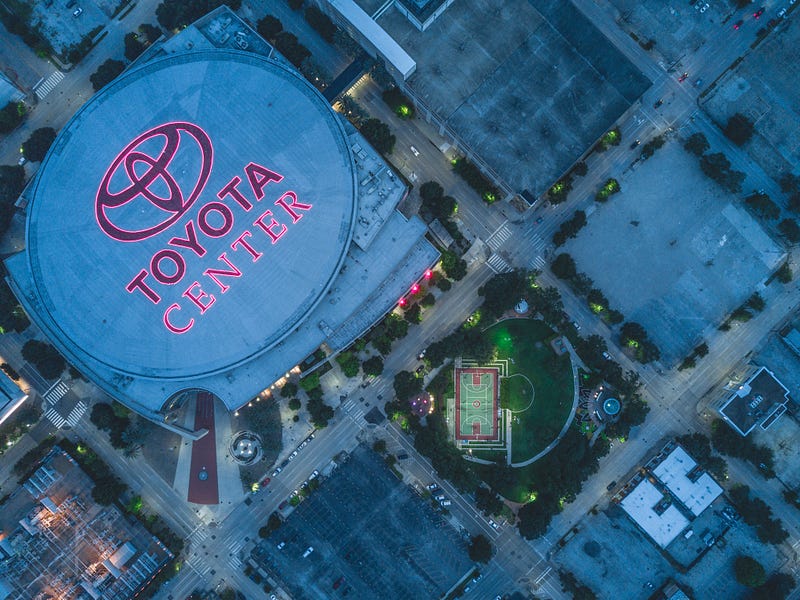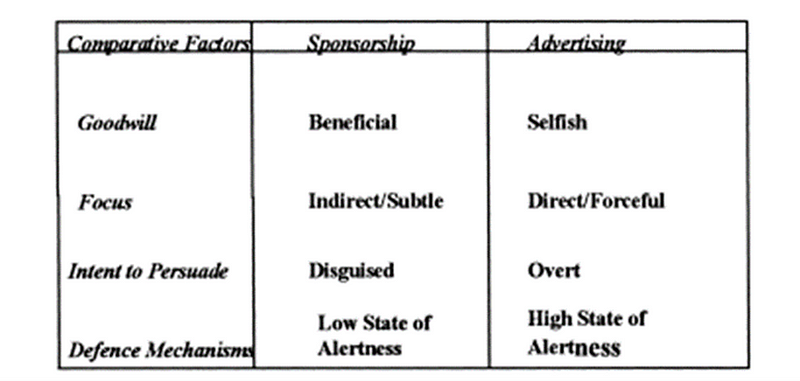
Do you have a local sports club that you support? Sponsors help them operate through providing funding or support in other ways. Some of the events you attend probably also receive sponsorship.
The biggest sports teams in the world have sponsorship splashed across the uniforms. The NBA has even succumbed to the lure of extra money after decades of refusing to have sponsor branding on the uniforms.
This blog explores what sponsorship is, how it works and its benefits to businesses.
What is Sponsorship?
Sponsorship involves a business relationship between two parties, where one party (sponsor) provides support in the form of funding, resources, or services to the other party (beneficiary), who in return provide access to the sponsor for rights and associations to be used for commercial advantage.
“(Sponsorship is) the provision of assistance either financial or in-kind to an activity by a commercial organisation, for the purpose of achieving commercial objectives.” (Meenaghan, 1983)
The sponsored party could be an event, organisation, or an individual; the involvement of this second party, distinguishing sponsorship from advertising.
Initial examples of sponsorship can be found over 100 years ago, but they are rare and on a small scale. Its use has exploded since the 1970s.
According to Meenaghan (2001), in the UK, spending on sponsorship increased from £4 million to $1075 million between 1970 and 1997. In the US, spending increased from $850 million in 1985 to $8.7 billion in 2000.
“Sponsorship involves two main activities: (1) an exchange between a sponsor and a sponsee, whereby the latter receives a fee and the former obtains the right to associate itself with the activity sponsored and (2) the marketing of the association by the sponsor.” (Cornwell & Maignan, 1998)
A common form of sponsorship is of sports clubs.
Your favourite sports teams are likely to have the logo of their key sponsor/s on their uniforms. This exposure on television, social media or other media holds value to the sponsor.
The sponsor could also be provided access to players for their own events or PR and corporate hospitality at their events or games.
How does sponsorship work?
Through the affiliation with an entity people care about, sponsorship helps to enhance the public perception of the sponsors’ brand. This affiliation creates a ‘halo effect’ of goodwill, where positive associations with the beneficiary of the sponsorship are reflected onto the sponsor.
Because sponsorship provides a positive benefit to society through empowering the existence of entities consumers care about, sponsorship is typically more positively perceived than advertising’s sole focus on commercial goals.
Advertising’s only interest is the profitability of the firm, thereby having no obvious benefit to the greater society. Advertising can also be coercive, resulting in alerting consumers’ defence mechanisms. Sponsorship’s commercial intent is more subtle and indirect, lowering consumer defence mechanisms.
Read more about persuasion knowledge for a better understanding of this process.
The table below shows a comparison between sponsorship and advertising characteristics.

Comparison between advertising and sponsorship (Meenaghan, 2001)
“Sponsorship works differently in relation to the consumer than do other forms of advertising and promotions in that it engages the consumer differently by bestowing benefit on an activity (e.g., sports or the arts) with which the consumer has an intense emotional relationship.” (Meenaghan, 2001)
Leveraging the partnership
To maximise the commercial result of their sponsorship, sponsors should focus their branding and marketing communications efforts on leveraging the association.
For example, along with displaying their branding on flags or banners at a sponsored event, social media posts promoting the event and the businesses’ role as sponsor.
Consumers can hold positive associations and deep loyalty towards sponsors of the sport, events, causes or other entities that they care deeply about. Sponsors proactively promoting their relationship enables these brands to leverage this emotional connection these consumers hold. The values of the sponsored activity or entity are then associated with the sponsor’s brand.
“Sponsorship appears to be another area of marketing, along with source effects, store atmospherics, brand extension, and brand alliances, where the consumer’s ability to see an association between marketing assets enhances the effectiveness of these assets.” (Cornwell, 1995)
Sponsorship fit
Sponsors invest in sponsorship to establish their credibility with their target market. For this practice to be effective, there needs to be an organic link in terms of similar goals, values, and vision, between the sponsor and the beneficiary of the sponsorship. One that makes sense to the public.
The sponsor’s target market should match the target market of the beneficiary they are sponsoring. Therefore, the right consumers have subjected the affiliation and the response is likely to be better if there is perceived to be a good fit between the two parties.
Also, passionate followers, fans or consumers of the sponsored entity judge the fit of the relationship and respond more (or less) positively than the typical consumer if the sponsor fits the same values.
If there is a fit, the sponsorship is perceived to be more sincere. This is seen as more authentic.
“Events, activities, and venues have been fully recognized for their ability to target a particular demographic or psychographic segment.” (Cornwell, & Maignan, 1998)
What are the benefits of sponsorship?
Sponsorship works in a way that it provides mutual benefits for the sponsor and the beneficiary. The beneficiary of the sponsorship receives funding or resources to operate.
Sponsorship has replaced other forms of funding such as government support in some countries to the extent that some sponsored activities rely on corporate funding to exist.
For a business, some of the key motivations for investing in sponsorship are improving goodwill, enhancing public relations, increasing brand awareness, improving brand image.
Improving profitability is obviously the end goal for any businesses’ strategic planning — these motivations contribute to enhancing the probability of this.
“The sponsor’s investment benefits the activity generates a goodwill effect among activity fans, which in turn influences their attitude and behaviour toward the sponsor’s brand.” (Meenaghan, 2001)
Goodwill
One of the key factors distinguishing sponsorship from advertising is the presence of goodwill. Goodwill from the sponsor in supporting the beneficiary and gratitude from consumers to the sponsor, grateful to them for helping out a favourite event, sport or organisation.
According to Meenaghan (2001), goodwill effects are mediated by the intensity of an individual’s involvement or connection with the sponsored entity.
Highly involved fans/consumers connection with a sports team for example can be deeply felt, and their awareness of the sponsor’s brand is likely to be higher than a casual fan/consumer.
Therefore, the goodwill affects for the sponsor are likely to be greater and they are more likely to develop a favourable opinion of the sponsor. This can trigger a strong preference for a sponsor’s products or service, increasing their purchase intention.
Goodwill also exists at different levels depending on the type of entity being supported by the sponsor. For example, the sponsorship of social causes typically generating more goodwill toward the sponsor than sponsorship of the arts or a building.
Enhancing public relations
Through sponsoring entities such as sports clubs that consumers care for, this fosters a socially responsible reputation. Improving community relations is a common sponsorship objective for corporations, especially banks, as they often do not have the best reputation.
As well as sponsoring well-known sports clubs, the organisation also sponsor local events or not for profit groups that benefit the local community where they are based. Other ways to benefit the community might be providing computers to a local school.
Sponsorship can be a relationship marketing tool.
Relationship marketing is the marketing activities that attract, develop, maintain, and enhance customer satisfaction and fostering customer retention. This was discussed in week 14.
Sponsorship can be a vehicle for developing relationships with the target market through signalling to them that our business shares similar interests and supports the same causes.
In B2B, It also helps create bonds with businesses partners who share a common sponsorship or strengthen their relationship with current and potential clients, through the use perks of sponsorship such as a corporate box at events.
Increasing brand awareness
Awareness of the sponsor’s brand is increased through the publicity of the entity they are supporting. It could be through advertising, TV coverage or other media such as social media or news articles, or people attending and seeing branding of sponsors.
Local businesses can increase awareness of what they are doing in the local community through an article in a local newspaper, whereas large corporations or consumer brands can put their brand in front of thousands or even millions of people through sponsoring a high-profile sports team with an audience on a global scale.
The All Blacks, Los Angeles Lakers or Manchester United, for example.

Sponsorship can provide a broader reach than advertising which will only reach a finite audience, depending on the platform.
“Activity followers, being most knowledgeable of the image values embodied in the activity, transfer these specific image values to the sponsor.” (Meenaghan, 2001)
Improving brand image
Cultivating positive and favourable brand associations (traits consumers attribute to a brand) and enhancing credibility is a benefit of sponsorship. Because of the goodwill factor, sponsors are viewed more favourably. This positively influences their brand equity.
Brand equity is the influence brand knowledge has on the consumer response to marketing. Brand equity strengthened when the consumer is familiar with the brand and holds strong and favourable associations with it.
Types of sponsorship
Sponsorship is typically associated with a sports team or event, but there are multiple forms of sponsorship. It can include concerts or the performing arts, and sports stars such as LeBron James are commonly sponsored by clothing companies such as Nike because of their global appeal.
Other sponsored entities include not for profit groups, charity or business events, associations, social media influencers and celebrities, buildings (often banks sponsor skyscrapers), and local government-funded venues such as stadiums.
One event could have multiple sponsors. Those sponsors might all contribute an equal amount for equal benefits, or there might be different tiers of sponsors. These have different levels of investment and sponsors receive individual benefits based on the value of their investment.
For an example of a business event — I run a networking event called Linkedin Local Hamilton, funded through sponsorship. It’s probably not what you expect — I wanted it to have an atmosphere more like a cocktail party.
Sponsors pay for the food and beverages of the people attending the event — usually around 150 people. Venues are offered for free, which is an in-kind sponsorship (discussed shortly).
Tickets to attend the event are free or donation-based, which means there is little income. The events rely on sponsorship to exist. The benefit to sponsors is the exposure of their brand as a sponsor in social media promotion and with the people attending the event.
It has worked well — I have run 13 events and counting.
Financial sponsor
There are two main types of sponsorship. Financial and in-kind sponsors.
A financial sponsor is also known as a cash sponsor and it is the most popular form of sponsorship. It is pretty simple — they give money to an entity in return for a promotion or other benefits outlined in their sponsorship agreement.
Some different types or levels of financial sponsorship are:
- Series sponsor — the highest status of sponsorship. the name and the logo of the sponsor are incorporated into the title of the series and other promotion, the rights to use teams, team members, players, coaches, and the series body in conducting joint promotions, right of presence at all official events.
- Title sponsor — similar to series sponsor, but for a one-off event. Many of the same benefits of a series sponsor mentioned above, another being branding placed around the stadium.
- General sponsor — also a large contributor (usually exist in the absence of a title sponsor), they receive the right to promote their association as a sponsor and often receive media coverage.
- Team sponsor — fund individual teams. They receive mention in media coverage of a team and often has on the uniforms and at their stadium. Special access to the team often provided.
- Official sponsor — is a sponsor that makes a certain part of raised funds (within 20–25%). Typically, the given status may be granted by category — for example, ‘official insurance partner’.
- Participating sponsor — is often one of the numerous sponsors and the benefits are not as extensive as the other sponsors. The size of their fee usually does not exceed 10% of total raised funds.
In-kind Sponsors
- Venue Partners — allows events to be hosted at their venue for a discounted or free rate. This allows the venue to gain exposure to a certain demographic.
- Prize Sponsors — donate items to be used as prizes at events such as spot prizes for doing activities or items to be included in a charity auction.
- Food Sponsors — at events, food sponsors offer free food to attendees. Catering can be a big expense for the organiser.
- Digital Sponsors — might provide a custom app for an event or live stream it to social media or a webpage.
- Media Sponsorship — marketing is provided on multiple communication platforms and PR, which can be valuable for not for profit/small businesses who do not have the budget or expertise themselves.
- Technical sponsor — provides goods or services, to a sports team for example in terms of medical skills or equipment or perhaps supplements.
Summary
In sum, sponsorship is a marketing tactic involving a business relationship between two parties — one being the sponsor who provides support in the form of funding, resources, or services to the other party (beneficiary); who in return provide access to the sponsor for rights and associations to be used for commercial advantage.
This article has discussed how sponsorship works and its benefits, different types of sponsorship, and what needs happen in order for sponsorship to be an effective marketing tool.
Thank you for reading.
I hope you enjoyed the content and learnt something new that you can apply to your business.
This article was originally posted on the BYB Marketing Blog: https://brandyourselfbetter.com/blog/post/208450/how-does-sponsorship-work

No comments:
Post a Comment